Baseball goes back a long way back in Hollywood, indeed to the very origins of motion pictures. One of the earliest depictions of the sport was an 1899 Edison Company production of “Casey at the Bat”, a brief film based on the popular poem. With a lineup numbering in the hundreds, cinematic baseball has covered a compelling cross-section of topics, and while there have been more than a few swings and misses through the decades, there are some gems.
Hollywood has produced some fine baseball-centric films including comedies (The Sandlot, Bingo Long), dramas (Moneyball, Soul of the Game), bios (Pride of the Yankees, The Stratton Story, The Rookie, Cobb) and even motion pictures covering the game through a foreign prism (Sugar, Mr. Baseball) and as a musical fantasy (Damn Yankees). So, by taking into consideration such factors as cast performances, quality of cinematography, costuming, how well the film’s pacing, camera angles and music reinforce its larger themes, and simply achieving verisimilitude being atmospheric of invoking a time and place, and most of all, good storytelling, here’s our rundown of the nine best baseball movies ever.
9. “42” (2013)
This real-life drama, written and directed by Academy Award winner Brian Helgeland (“L.A. Confidential”), features Chad Boseman as Jackie Robinson and Harrison Ford as Branch Rickey. In 1947, Rickey put himself at the forefront of history when he signed Robinson to the Brooklyn Dodgers, breaking Major League Baseball’s infamous color line. But the deal also put both player and executive in the firing line of the public, the press and other players.
The key to the film was capturing the essence of the man wearing number 42 on and off the field.
“You know every textbook representation of Jackie Robinson mentioning him breaking the color barrier in baseball is useful, but there is nothing like the visceral experience that an audience can have when they see, when they can feel, participate in the experience that Jackie Robinson had. That is what I think is most important about this (film) version of it,” said Harrison Ford.
“As someone who is a sports fanatic and an athlete, one of my biggest pet peeves as a movie fan is when it is very obvious to the audience that the actors portraying an athlete have never played the sport in their life and it just takes you out of the moment, “ says the film’s producer Thomas Tull (“The Dark Knight Rises”, “We Are Marshall”, “The Hangover”), “From a cast perspective, (actor) Chad Boseman, who is a great natural athlete, spent months training to get ready for the role both with Phil Carlson, a great physical trainer and several baseball coaches and coordinators.”
However, in addition to capturing the physical elements of him like the way he held his held and swung his bat, the way he ran, being pigeon-toed, it was imperative they also reflect his personality and mindset.
Robinson was a fighter. In order to endure what he’d have to go through, it was necessary for that person to have a fighting spirit. With that duality of not fighting there’s the internal struggle within him.
“Doing a character, you want to know the full landscape. Mentally, physically I found that one can’t be a hero, a protagonist if he’s a pacifist. It had to be an internal struggle where he’s fighting himself, fighting his normal tendencies,” explained Boseman in his approach to portraying Robinson.
Resisting the urge to retaliate, he couldn’t even say anything let alone, physically strike back. As Rickey made a point of saying, Robinson had to have ‘the courage not to fight back’.
“I think at a certain point he understood that this situation was bigger than himself,” said Boseman. “That what he was going through was for other people as well. I think that’s what allowed him to do it.”
8. “61*” (2001)
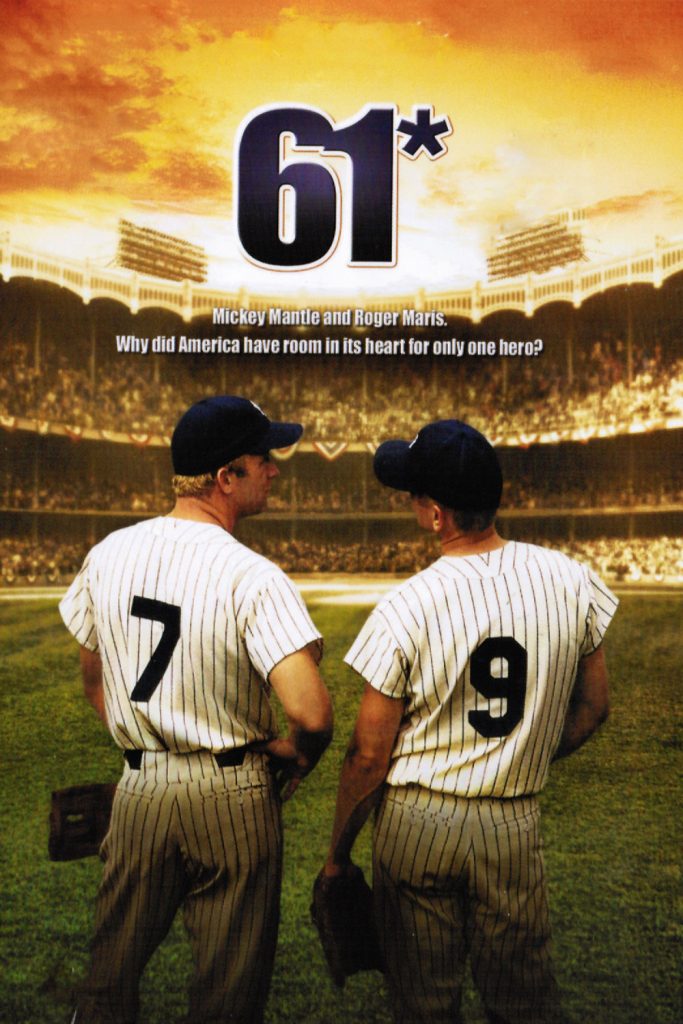
During the summer of 1961, two New York Yankee sluggers, Mickey Mantle and Roger Maris, are in a race to break Babe Ruth’s single-season home run record-60, set in 1927. (The asterisk in the movie’s title refers to the Commissioner Ford Frick’s edict that the record books show that Maris’s record came in a 162-game schedule as opposed to Ruth’s 154).
“What made me want to tell this story is that it’s not only about baseball,” said the movie’s director Billy Crystal, ‘It’s really about two men – competitors, teammates and friends who come to respect each other.”
Casting was excellent. And with the help of switch-hitting, seven-time all-star Reggie Smith, actor Thomas Jane learned to swing from both sides of the plate like Mantle. As a natural righty, Barry Pepper effectively learned from scratch how to hit left-handed as Maris.
Another nod to verisimilitude was Crystal’s ability to gather experts and convert old Tiger Stadium in Detroit to look like Yankee Stadium of the early 60s.
“With planning, sketching, CGI work along with the talents of two-time Academy Award winner Haskell Wexler as our director of photography, you’d swear you were in ‘The House That Ruth Built’” boasted Crystal. “When you see our guys walk onto the field and you hear Bob Sheppard, the Yankees PA announcer for 50 years, give the batting order, this old ballpark comes to life. You are living it four decades later. I’m very proud.”
7. A League of Their Own (1992)
As World War II raged on and all the men are fighting the war, most of the jobs that were left vacant because of their absence were filled in by women. The owners of the baseball teams, not wanting baseball to be dormant indefinitely, decide to form teams with women. So, scouts are sent all over the country to find women players.
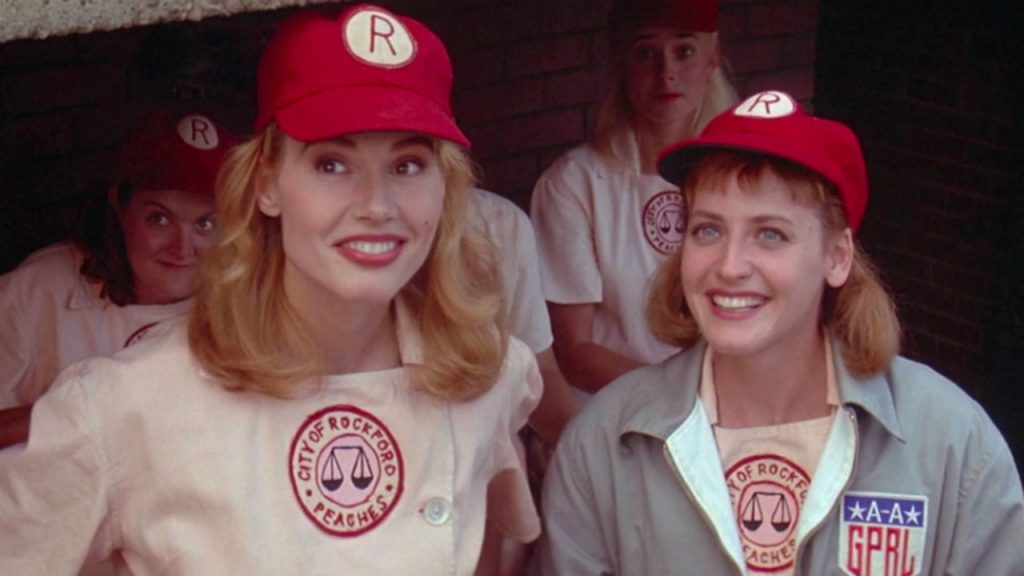
It would not be difficult to find actresses interested in portraying those players, because as actress Lori Petty said, “It was the biggest thing in town. As a female movie actor you just hope to get the role as the girlfriend or the whore that broke up the marriage. There’s like two roles, right? You can’t play the gas station attendant. You can’t own the grocery store. This was the 90s. you were the love interest. To have a film that was a true story with lots of good women parts in it, is impossible. Every actress on the planet auditioned. I didn’t know this story. And I was an athlete my whole life. So to A) tell this story and B) play baseball for 6 months, I was like ‘are you kidding?!’”
Directed by long-time sports fan Penny Marshall, this is a story of two sisters (Geena Davis, Petty) who join the first female professional baseball league and struggle to help it succeed amidst their own growing rivalry.
Petty (“Point Break”, “Orange is the New Black”), though she auditioned multiple times, explains how she got the part.
“I auditioned eight times okay? (but) I was one of the first people cast because I am an excellent baseball player. I was like the Bad News Bears. I was the pitcher on the boys Little League team.”
Despite a majority of the cast being female, Jon Lovitz’s small role played big to audiences as Ernie Capadino, a league scout who “discovered” the sisters.
“He was given free reign, would improvise and was just hilarious, “ recalled Petty,” We did one scene where the cow doesn’t moo until Jon talks. Lovitz would yell over to Penny, “I can’t work like this’ and she’d yell ‘just tell it to shut up!’.
So in the movie we see him say ‘will you shut up!’ I’m doing everything not to laugh. Jon was so good at that.”
“You may notice in the movie if you see the back of Lovitz’s head, they put jokes in his mouth so if we are walking on the train you don’t see his lips move, anytime, anytime you see the back of his head, they wrote another line for him to say because he was so funny,’ revealed the actress.
Of course, it was Tom Hanks’ delivering the film’s most famous line, ‘There’s no crying in baseball’.
6. Major League (1989)
If crying was allowed, with their long cycle of failure, back in the late 80s, one couldn’t blame Cleveland Indian fans for crying. But Hollywood did make them laugh with an engaging ensemble of misfits in “Major League”.

The new owner of the Cleveland Indians (Margaret Whitton) puts together a purposely horrible team so they’ll lose and she can move the team. But when the plot is uncovered, they start winning just to spite her.
Written and directed by Oscar winner David S. Ward (“The Sting”), one of the featured actors was no slouch on the field. His athletic reputation on the diamond helped get Charlie Sheen (“Wall Street”, “Platoon”) the role of pitcher Ricky “Wild Thing” Vaughn without an audition. Sheen had attended the prestigious Mickey Owen Baseball School for several years while in high school.
And though he could throw some heat, Sheen was honest with his director saying, ‘David I promise you, I can’t throw 98 because if I could, I‘d be doing it for a living’, but I can do enough you can then make it look as such’.
So much so that the director practically wore his star pitcher out.
“There was a time that my arm was so tired, there was no 4 or 5-man rotation. It was 115 pitches starting at 5 in the morning, then come back the next day and throw 120 more, “It was insane. Just a lot of throwing. Any days off I’d be going to physical therapy. Cortisone shots. It was really gnarly,” recalled Sheen with a grimace, but quickly followed by a satisfied smile, “But there were a couple nights we had 30,000 people in the stands. And they were fabulous. So you get all that adrenaline going and suddenly you’re pain free, but at the end of the day you are saying to yourself ‘oh my gosh!’”
That’s what the executives at Paramount Studios were saying when their movie became a hit.
5. Bad News Bears (1976)
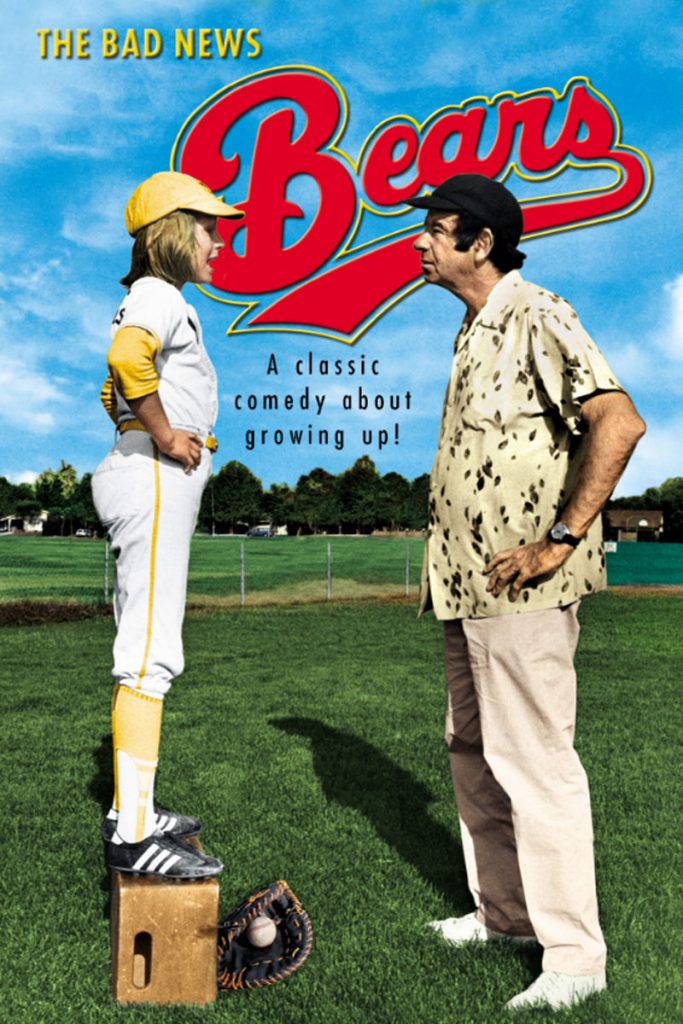
As one of the original sports movies to use a ragtag group with fine critical success, “The Bad News Bears” is a beloved classic, often-imitated never surpassed.
Directed by Michael Ritchie (“Downhill Racer”, “The Candidate”) and written by Burt Lancaster’s son, Bill, it is the story of an aging, down-on-his-luck ex-minor leaguer (Walter Matthau) who coaches a team of misfits in an ultra-competitive California little league. His ace is a girl, Amanda (Tatum O’Neal), the 12-year-old daughter of one of his former girlfriends, and over the years he’d developed her into a first-rate pitcher.
“I grew up with the “Bad News Bears”,” said actor Charlie Sheen, “It was like when Emilio (Estevez) did the first “Mighty Ducks” at an early screening, I said to him, ‘dude you have a giant hit because you’ve re-created “The Bad News Bears”.
(Walter) Matthau and Vic Morrow were terrific. I mean Chico the Bail Bondsman (team sponsor) come on, amazing!”
“The most underappreciated baseball movie of all time was the original Bad News Bears. It is about America. It is about suburbia,” said actor/comedian Robert Wuhl (“Cobb”, “Batman”, Bull Durham”, “Arliss”.
4. Field of Dreams (1989)
Kevin Costner (“Yellowstone”, “JFK”, “Dances with Wolves”) is Iowa farmer Ray Kinsella who is inspired by a voice he can’t ignore to pursue a dream he can barely believe. Supported by his wife (Amy Madigan), Ray is directed by the spirit to go on the road to garner the help of Terrence Mann, a famous writer (James Earl Jones) who has disappeared from sight, and north to Minnesota to talk to Dr. Archibald ‘Moonlight’ Graham (Burt Lancaster) who never got the chance to play with the pros.
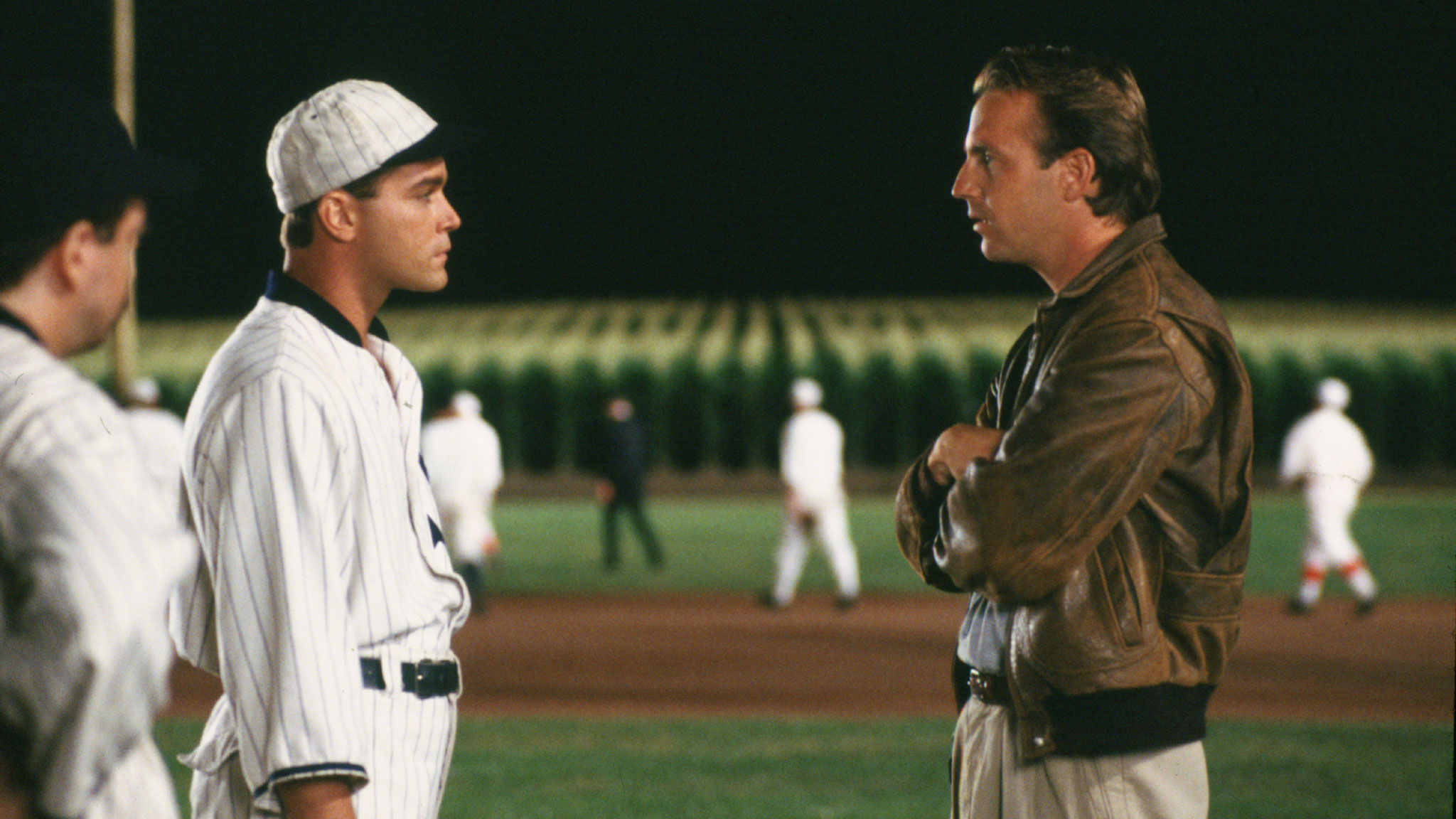
Unable to pay the mortgage, the Kinsellas, having plowed under a portion of their crop and spent all their savings to fund Ray’s obsession, plow on, further testing Ray’s faith to build a place where dreams can come true.
“If you build it, he will come.” In a fantasy film that would be a good throwback as a dream story with Frank Capra at the helm directing, say Jimmy Stewart, director, Phil Alden Robinson, and the writer, W. P. Kinsella, (despite having Ray Liotta hitting righthanded for one of the all-time great left-handed hitters, in Shoeless Joe Jackson) waxing ever poetic over the glories of the game pull off a very tricky story.
3. Eight Men Out (1988)
A heavy topic is at the center of “Eight Men Out”, where talented but disgruntled and underpaid players for the Chicago White Sox accepted bribes to deliberately lose the 1919 World Series, dubbed The Black Sox Scandal.
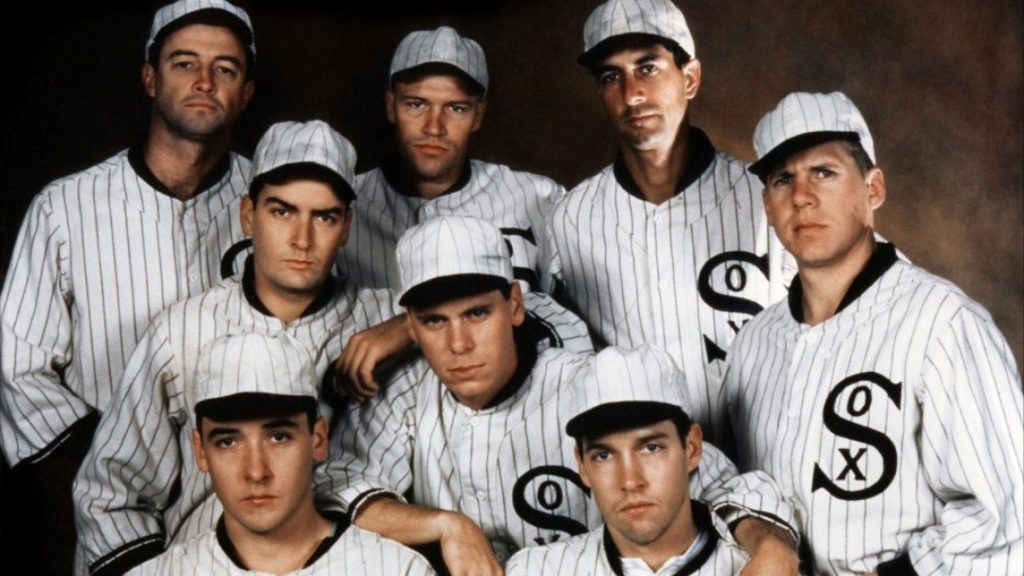
Barbara Boyle, the film’s producer, recalls her fight to try to even get into the game as Hollywood wasn’t in a rush to finance a dark, ensemble, period-piece.
“The studios kept the budget low because they factored in (that) the story did not have global appeal. They asked if I could do it for $5million. I said I could come very close. To do that we couldn’t afford to build anything. The final negative cost just came under $6 million. Factor in these things: a sport that does not translate; a historical period piece; and no one central character (rather it was an ensemble). Even today those things are problematic for getting a green light”.
But even on the shoestring budget, Boyle, along with writer/director John Sayles, managed to pull off a very realistic look with the help of talented and resourceful production and costume designers (Nora Chavooshian, Cynthia Flynt) as well as a riveting cast.
This film’s version of Shoeless Joe Jackson, no scholar but a magician with the bat, was played by D.B. Sweeney (“The Cutting Edge”), a natural right-hander who worked out in the minor leagues to learn to hit from the other side of the plate.
“He looked great. He was smooth as silk,’ said castmate Charlie Sheen who portrayed his teammate, centerfielder Hap Felsch,” You can tell. You can tell the guys that have played the game. You can tell by the way he walks onto the field. “
While Sweeney and Sheen markedly enhance the game sequences with their very real baseball skills, there’s an all-star group of performers here. Clifton James (“Live and Let Die”, “Superman II”) gives a fine performance as the team’s greedy owner, Charles Comiskey, living the good life off the sweat and toil of his players. John Anderson (“Psycho”, “Maverick” ) captures the authoritative Judge Kenesaw Mountain Landis. All the gamblers, too, are well cast, especially Michael Lerner as Arnold Rothstein, a powerful figure, endlessly seeking revenge for the scars of his youth when he was ridiculed for his lack of athleticism.
2. The Natural (1984)
Reportedly offered a baseball scholarship at the University of Colorado before eventually dropping out, Robert Redford showed some convincing athleticism, swinging the bat well as a 46-year-old during the production of “The Natural” as Roy Hobbs, a middle-aged unknown that comes seemingly out of nowhere to become a legendary baseball player with almost supernatural talent.
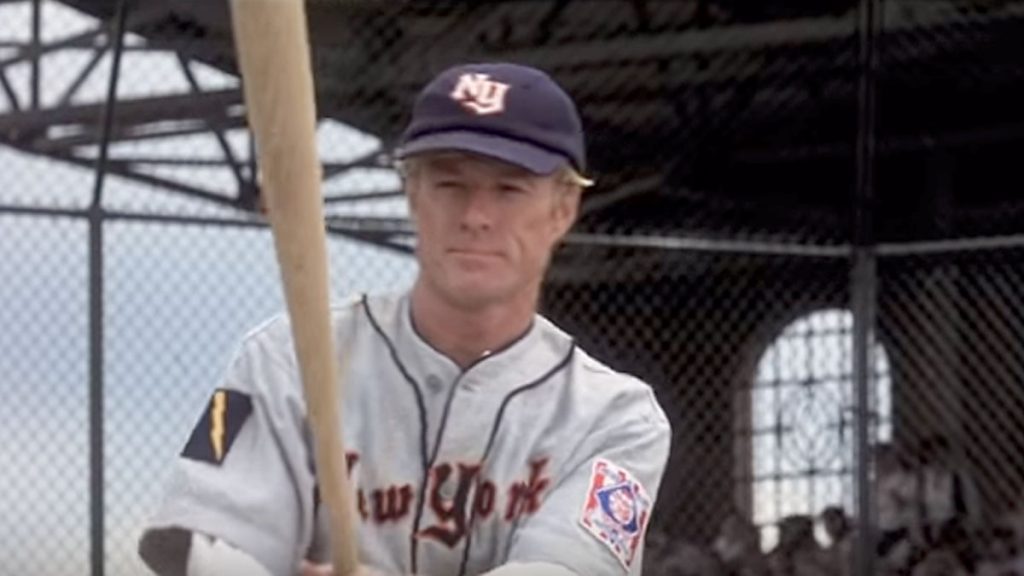
Back in 1969, Redford was ‘a natural’ portraying a world-class skier in “Downhill Racer”.
A more upbeat version of the popular novel (in Bernard Malamud’s 1952 book, Hobbs strikes out in the critical at bat), the film is about second chances, but what really shines is its visual brilliance.
Helmer Barry Levinson’s Director of Photography, Caleb Deschanel (“The Black Stallion”, “The Right Stuff”, “Anna and the King”)” masterfully conveys many of the story’s themes through visual expression rather than dialogue. Aided by a brilliant production design team, the cinematographer’s work is worthy of hall of fame status.
1. Bull Durham (1988)
A former infielder in the Baltimore Orioles farm system, Ron Shelton knew baseball intimately, and though his script would earn him an Oscar-nomination, it was a long road to get there, yet his film would have a big impact on the genre.
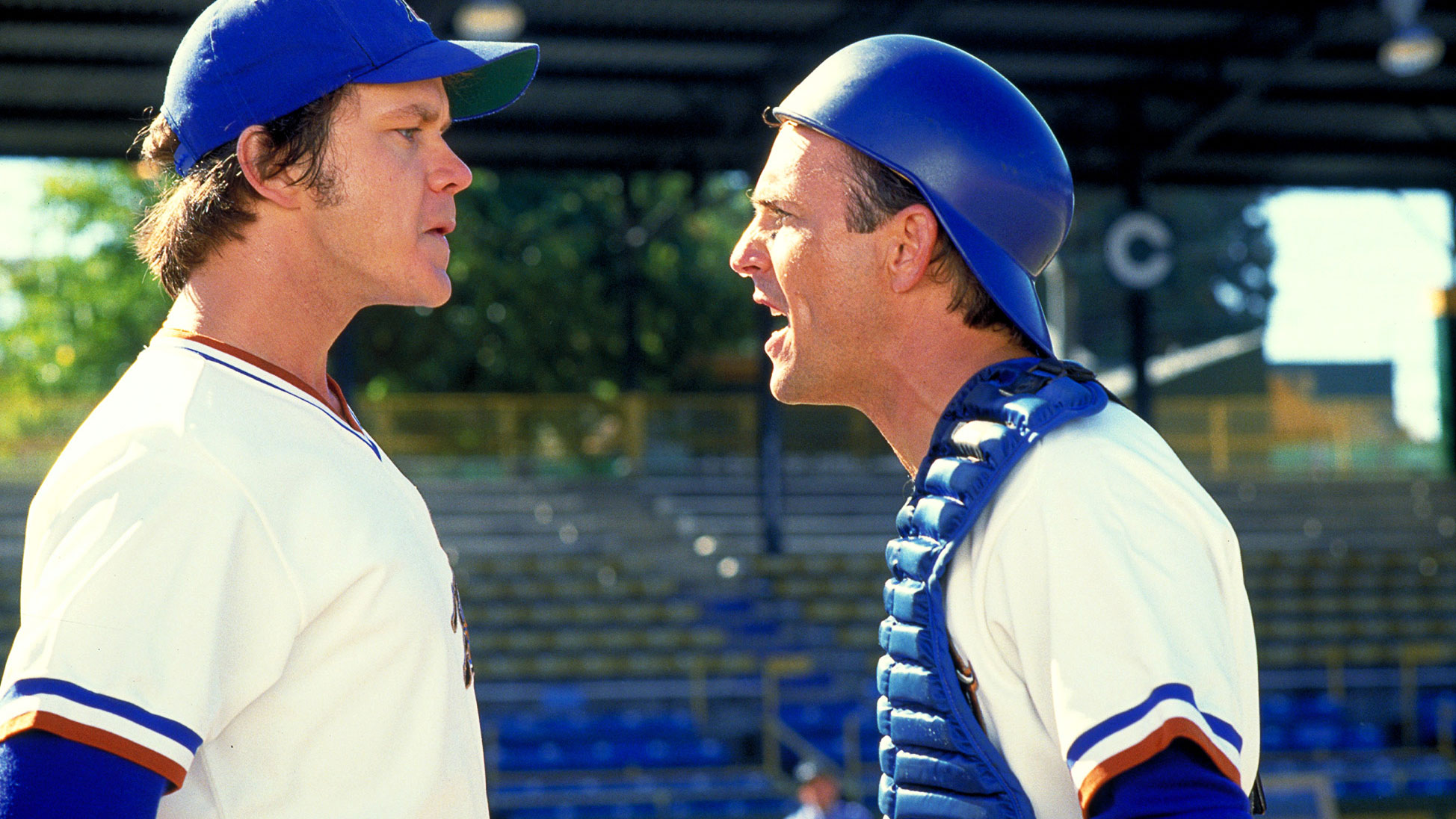
One reason “Bull Durham” is different, is that it is about a player trying to keep his job. It’s told from the point of view from somebody in the arena, not from the fan’s perspective.
Robert Wuhl, who was a featured cast member in this film as the fast-talking pitching coach Larry Hockett, and would later co-star as sportswriter Al Stump in Shelton’s drama “Cobb” about baseball legend Ty Cobb, has a theory he shares with the writer /director.
“Most sports movies suck,” said Wuhl, the star of “Arliss” (the long-running tv series on HBO where he portrays the head of a sports agency who will do anything for his very famous clients), “And generally the reason why they suck is that they are about “The Big Game”. That is basically *&%$$. The fan only cares about one thing- did the team win or did they lose? That is all they care about. They don’t care about how you got there. They don’t care what you did to get there. They don’t care about anything except if they won or lost.”
“Your best sports movies, like “The Hustler”, “Requiem for a Heavyweight”, “Raging Bull” there’s no big game,” continues Wuhl. “The Bad News Bears there is a big game, but they lose. You also have to remember too, that baseball is primarily about losing. The three most important pieces of literature written about baseball all end in failure – Casey at the Bat, The Natural and Take Me Out to the Ball Game. 1,2,3 strikes you’re out. All of them end in failure. Baseball is about dealing with failure. “Eight Men Out” is another.”
“Bull Durham” is also different in that it is a rare baseball-centric film told largely from the point of view of a woman. A knowledgeable woman who has an affair with one minor-league baseball player each season, but this year she gets involved with not only an up-and-coming pitcher (Timothy Robbins) but also the experienced catcher assigned to him (Kevin Costner).
Casting veteran Bonnie Timmerman, whose credits include contributing to the casting of four films that were nominated for the Best Picture Oscar: “Amadeus” (1984) – (though not as a casting director); “Awakenings” (1990), “Quiz Show” (1994) and “The Insider” (1999). Of those, Amadeus was a winner in the category, talks about the casting on “Bull Durham”.
“Susan Sarandon was a favorite of mine and I always hoped that she would get the role. It was an incredible movie to cast from beginning to end. (but) Julia Roberts and Winona Ryder were some of the unknown actors that came in to audition and meet for the movie along with so many others that went on to be important actors.”
“You could always tell whether or not a movie is going to be successful when you have a great script to begin with,” added the accomplished Timmerman, “Ron Shelton was a wonderful writer and director.”
One of the things film fans forget is that when Shelton pitched the movie, he had a hard time convincing a studio to give him the opportunity to direct. Baseball movies were not considered a viable commercial prospect at the time and every studio passed except for Orion Pictures who gave him a $7 million budget (with many cast members accepting lower than usual salaries because of the material), an eight-week shooting schedule and creative freedom. The film’s success helped spark a boom of baseball movies soon afterward, including Major League, Field of Dreams, Eight Men Out, and A League of Their Own.
Despite often coming to the plate with two strikes against them, producers continue to find ways to score with their baseball projects largely because they’re driven by passion.
Why do baseball films continue to find audiences?
“Because it taps into something that’s woven deeply so much into different elements of our upbringing,” said Sheen. “You go from hero to zero from one pitch to the next so it lends itself to the film camera not just what is on the field, but all the complicated stories off the field. It taps into filmgoers’ age-old thirst for underdog stories. So many people can relate to that.”

